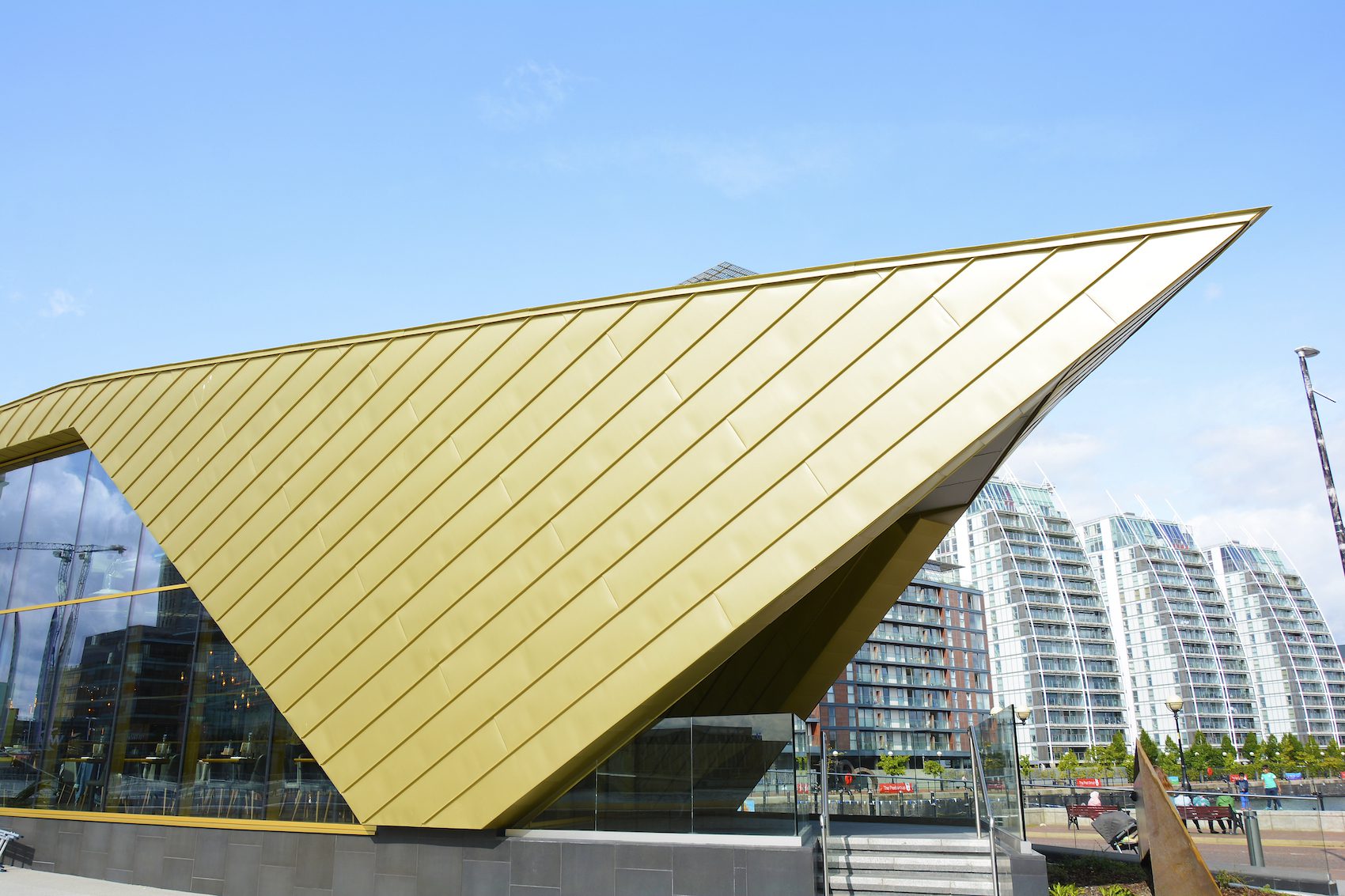Simon Walker, Category Manager at SIG Zinc & Copper, discusses the dos and don’ts of standing seam zinc roof build-ups with Architecture Today’s Technical Editor John Ramshaw.
In association with![]()
Photos
Terence Smith
For more than a century, standing seam zinc roofs have appealed to architects for reasons of aesthetics, weather performance, durability, and – latterly – sustainability. While it is clearly important to specify a high-quality metal, such as elZinc from SIG Zinc & Copper, the design of the roof build-up below the zinc is critical to the overall success and longevity of the finished roof. So what are the different build-up options available? When and where should they be used? And what are the main pitfalls to avoid? Simon Walker, Category Manager at SIG Zinc & Copper, discusses these questions and more, with Architecture Today’s Technical Editor John Ramshaw.
Located on Salford Quays in Manchester, The Alchemist is a visually striking bar and restaurant designed by Reid Architects
What building elements are typically involved in standing seam zinc roof build-ups?
Depending on the design of the roof, the principal elements – going from outside to inside – may include zinc, underlay, substate, air layer, insulation, vapour control layer (VCL) or vapour barrier, and the main loadbearing structure. The underlay has a multifunctional role and can act as a separating layer, slip layer, or protection for the substrate during construction. Combined with a breather membrane, structural underlays can drain condensation away from the underside of the zinc, ameliorate minor unevenness in the substrate, and – in the case of elZinc applications – improve the longevity of the roof.
What are the main options in terms of the roof build-up?
Ventilated and unventilated roofs are the two options most frequently used with elZinc. These are also referred to as ‘cold’ and ‘warm’ roofs respectively.
The single-storey building is clad in standing seam elZinc Rainbow Gold Protect zinc over composite panels, which provide both insulation and acoustic attenuation
How should specifiers choose between the them?
This depends on a range of factors, including the shape and height of the roof, aesthetic concerns, and of course cost. These are best discussed on a project-by-project basis with SIG’s technical team, but there are a number of key parameters that are worth knowing when considering ventilated and unventilated roof designs.
Ventilated (cold) roofs tend to work best with a decent pitch and simple geometry. There also needs to be an adequately dimensioned air gap. They are not particularly suited to low pitched roofs (unless good cross ventilation can be guaranteed), geometrically complex roof structures (where the required height of the air layer is problematic), and roofs that require discreet ridge details.
83 Barchester Street, London, is an exemplar affordable housing scheme designed by Metropolitan Workshop
By contrast, unventilated (warm) roofs are frequently used on projects with low and/or complex roofs, or where a slimmer roof build-up is required. However, they should be avoided on installations over humid substrates, which can trap moisture. Warm roofs are also more sensitive to poor construction practices. For example, improper installation of the vapour barrier can, in cold weather, lead to condensation on the internal face of the zinc. Timber substrates can be used in conjunction with warm zinc roofs, but the need to reduce cold bridging has led to the adoption of rigid or composite insulation boards as substrates.
The project’s saw-tooth-profiled upper storeys and roof are clad with standing seam elZinc Rainbow Brown zinc from SIG Zinc & Copper
How should architects approach the design of ventilated zinc roofs?
Central to all ventilated (cold) zinc roofs is the inclusion of an air layer under the substrate. This draws warm, moist air out from under the zinc, while also helping dissipate heat in the summer. The air inlets and outlets can be formed in the ridge and eaves using perforated elZinc materials as an insect mesh. If a structural underlay is required, any draining membrane installed below it should be breather membrane. This will allow any condensate to evaporate down through it and the substrate into the air layer, where it can be expelled from the roof via the outlet.
A typical build-up for a ventilated roof on sheathing would be (from outside to inside): elZinc standing seam tray, standing seam clip, underlay (structural underlay and breather), substrate, ventilation path/air gap, air layer batten (height = air layer thickness), breather membrane, insulation, timber rafter, vapour control layer (VCL) with sealed laps, and ceiling finish.
The warm roof construction is formed of trapezoidal steel sheets fixed to timber rafters, then a layer of rigid PIR insulation, followed by acoustic matting, a breather membrane, and zinc standing-seam cladding.
What are the main design principals behind unventilated zinc roofs?
Warm or unventilated zinc roofs employ a high-performance – and when required – self-sealing vapour barrier on the warm side of the insulation. As I mentioned before, the vapour barrier is vital to the overall performance of the roof, so specifiers should ensure that it is always installed over the structural deck; it wraps around all edges of the insulation; every joint and penetration is properly sealed; and the installation is carefully controlled on site.
A typical build-up for an unventilated roof on rigid insulation would be (from outside to inside): elZinc standing seam tray, standing seam ‘warm-fast’ clip with stainless steel grip plate and spacer plug; structural underlay with waterproof membrane, rigid insulation, self-sealing high-performance vapour barrier, decking (plywood or OSB), timber rafter, and ceiling finish. It is worth noting that only one screw is required per clip, so it is important to check the pull-out values and clip centres, as well as deck thickness.
Contact Details
For more information, please visit the SIG Zinc & Copper website.
Source: Architecture Today







